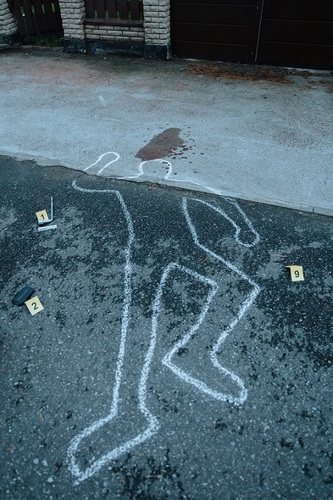
–>
January 22, 2023
Unfortunately, I know firsthand what secondary victims of homicide deal with since my 23-year-old brother, Seth Alan Barkas, died from the injuries caused by a stabbing during a mugging several days before by a teenage gang. I was 20 years old at the time and majoring in fine arts at Hofstra University. I know it sounds naïve, but back then, before the Internet and social media, I thought violent crimes like that only happened to other families, not to my upper middle-class family with a dentist father and a kindergarten teacher mother. Seth was an aspiring playwright, film critic for Baltimore magazine, and a freelance theater critic for a major national theatre newspaper. It was on his way home from reviewing an off-off-Broadway play that the stabbing occurred in Manhattan’s East Village.
‘); googletag.cmd.push(function () { googletag.display(‘div-gpt-ad-1609268089992-0’); }); }
There is such widespread coverage of crime today that it is hard to remember a time when there was maybe just a brief mention in a newspaper, if that. Crime victimization was not played out in the public eye the way it is today. Today, few are unaware of the tragic stabbings of four college students in Moscow, Idaho on November 13, 2022, the weeks of fear and conjecture that followed, and the arrest of the alleged suspect, who is in jail awaiting his next court appearance in six months.
The media has tried to keep the names, ages, and even some of the details about each of the four victims in the public eye so as not to focus only on the alleged assailant. This is a positive development compared to the situation decades ago. Consider the horrific murders committed by Richard Speck, who killed eight student nurses in Chicago in July 1966. Or the BTK Killer, who was finally arrested and put in prison in 2005, who had killed ten victims over the course of thirty years.
Most of us would be hard pressed to recall the names of even one of the 18 victims of both Speck and the BTK Killer, a/k/a Dennis Rader.
‘); googletag.cmd.push(function () { googletag.display(‘div-gpt-ad-1609270365559-0’); }); }
By contrast, many know the names of all four victims of the November 2022 tragedy in Idaho: Ethan Chapin, 20; Madison Mogen, 21; Xana Kernodle, 20; and Kaylee Goncalves, 21. But that is small comfort to the parents, siblings, friends, and classmates of these innocent victims who are dealing with the violent deaths of their loved ones.
The media has been trying hard to make the victims of the Idaho massacre more than just names and ages as they have been sharing details about their interests, goals, and hobbies.
However, the process of grieving is still the same. In my book Victims, originally published back in 1978 by Scribner, and, decades later, in my textbook, Essentials of Victimology, I share the reactions to the sudden news that someone has a terminal illness, the five stages of grief theorized by hospice doctor Dr. Elisabeth Kubler-Ross, applying it to finding out a loved one is a homicide victim, namely, Denial, Anger, Bargaining, Depression, and Acceptance. David Kessler, who worked with Dr. Ross, wrote a book published in 2019 in which he adds a 6th stage, namely, Finding Meaning.
For me, finding meaning has been critical as a way that my brother’s murder would be more than a statistic for homicides in 1969. Finding meaning for me began when I put my art and therapy career goals aside and obtained an MA in criminal justice (Goddard College Graduate Program), followed by publishing Victims, an expansion of my master’s thesis, “Victims of Crime and Social Change.”
I have been teaching criminal justice and criminology courses since my mid-twenties, even before I received my graduate degrees. Over the years, in addition to obtaining my Ph.D. in Sociology, with specialization in the areas of Deviance/Crime, Family, and Medical Sociology, I have taught criminology, sociology, and victimology courses at several colleges and universities, Since august 2014, at John Jay College of Criminal Justice, where I am an Adjunct Associate Professor.
 It is hard to believe that my older brother Seth Barkas has been gone more than 50 years. My sister Eileen and I fortunately can still reminisce about the positive family memories we share. Seth was married at the time of his murder; his adopted son was five and he and his wife were about to welcome a second son two months after Seth died. Those sons have grown up and have families of their own; my brother, if he had lived, would even have become a great grandparent in the last year.
It is hard to believe that my older brother Seth Barkas has been gone more than 50 years. My sister Eileen and I fortunately can still reminisce about the positive family memories we share. Seth was married at the time of his murder; his adopted son was five and he and his wife were about to welcome a second son two months after Seth died. Those sons have grown up and have families of their own; my brother, if he had lived, would even have become a great grandparent in the last year.
‘); googletag.cmd.push(function () { googletag.display(‘div-gpt-ad-1609268078422-0’); }); } if (publir_show_ads) { document.write(“
For me, finding meaning has saved me from the depression and potentially life-threatening condition known as PGD, Prolonged Grief Disorder. My late father, who died of an inoperable brain tumor when he was 80, never found meaning in my brother’s murder and, sadly, depression changed his personality. As I said in my eulogy when my dad passed away and I restate in my new autobiography, Looking Backward, Going Forward: Reflections on a Writer’s Life, there were two Bill Barkases. The one before and the one after my brother’s murder.
Over the years, I have interviewed numerous victims of crime, in person or via Zoom, including the secondary victims of homicide such as Tereson, whose 21-year-old son shot and killed his father, her ex-husband, before turning the gun on himself; Fred Guttenberg, whose 14-year-old daughter Jaime was one of the seventeen killed at the high school in Parkland, Florida on Valentine’s Day, February 14, 2018, and even Kerri Rawson, the daughter of the BTK killer and author of the powerful memoir, A Serial Killer’s Daughter.
We, the secondary victims of homicide, find ourselves part of a unique category of victims that we never asked to join. Knowing that the perpetrator has been caught provides some relief but it does not minimize the lifelong “What ifs” that so many of us experience. For some it might be a “what if” as a way to have stopped the murder but for others, like me, the “what ifs” are more like how someone would have looked five, ten, or twenty years after their untimely death, or what they might have achieved in their lives had it not been cut short.
My brother Seth was not perfect, but he was a talented, unique, and loving person who is dearly missed. When I was conducting research for Victims, I interviewed some of his friends at NYU or from Bayside High School as well as one of his professors. His professor told me that many students talk about wanting to change the world, but he believed my brother would have actually done it.
So maybe that’s one of the biggest “might have been” that the parents, siblings, friends, and classmates of the four Idaho murder victims must contend with as well as all the approximately 20,000+ victims of homicide each year in the United States. That number is far greater than any other western country where, on average, the number of victims, adjusting for population, is vastly smaller– in the United Kingdom, for example, there were 594 homicide victims in the year ending March 2021 on a population of 67 million compared to our 332 million. Or consider that in 2020, France had a population of 67.57 million and homicide deaths of 879. If you multiply that by five, since the U.S. population that year was 329.5 million, it would equal 4,395 murder victims. Yet the U.S. had 19,384 murder victims that same year.
We need a catalyst for changing our high murder rate in the U.S. the way Michelle Alexander’s book, The New Jim Crow, helped to wake up America to a mass incarceration problem. Going back even further, consider how Upton Sinclair’s 1906 novel, The Jungle, and its disclosure of the conditions in the meatpacking industry is said to have led to the passage later that year of the 1906 Pure Food and Drug Act and the Meat Inspection Act.
The answers are not simple. I have been teaching the Sociology of Mental Illness at John Jay College of Criminal Justice during the Winter Break. The research confirms that the mentally ill are more likely to be the victims of violence than the perpetrators, but untreated mental illness does contribute to the homicide problem. A recent real-life example is the stabbing death of a 71-year-old woman on her way home from her night shift job by a young man whose mother said he is a bipolar schizophrenic homeless man who often does not take his medication.
On behalf of my brother, Ethan Chapin, Madison Mogen, Xana Kernodle, and Kaylee Goncalves, their parents, siblings, friends, professors, and classmates, as well as the nearly 20,000 homicide victims in the U.S. annually, and the hundreds of thousands of homicide victims around the world, let us agree to work harder to find a way to reduce the number of homicide victims going forward. It may be true that the nineteenth-century sociologist Emile Durkheim believed that crime is inevitable, but we can certainly make it a rarer occurrence rather than the far too common heartbreaking situation that it has become today.
Jan Yager, Ph.D. is the author of 50+ award-winning books, translated into 35 languages, including Victims (Scribner, 1978; with a new introduction, Hannacroix Creek Books, 2021); Essentials of Victimology (Aspen Publishing, 2022); Friendgevity (with a Chapter on Frenemies and Fatal Friends); When Friendship Hurts; Looking Backward, Going Forward: Reflections on a Writer’s Life; the novels On the Run, Untimely Death, Just Your Everyday People, and other titles. For more on Jan, visit https://www.drjanyager.com
Image: Pexels
<!– if(page_width_onload <= 479) { document.write("
“); googletag.cmd.push(function() { googletag.display(‘div-gpt-ad-1345489840937-4’); }); } –> If you experience technical problems, please write to [email protected]
FOLLOW US ON
<!–
–>
<!– _qoptions={ qacct:”p-9bKF-NgTuSFM6″ }; ![]() –> <!—-> <!– var addthis_share = { email_template: “new_template” } –>
–> <!—-> <!– var addthis_share = { email_template: “new_template” } –>






